Key takeaways:
- Understanding genealogy research involves piecing together stories from records, despite potential conflicting information.
- Organizing research is crucial for clarity, preventing loss of valuable links to family history, and enhancing the narrative for sharing with others.
- Using tools like family tree diagrams and digital software can streamline research, making it more cohesive and accessible.
- Implementing a systematic organization strategy with regular reviews and milestone goals boosts productivity and aids in uncovering hidden discoveries.
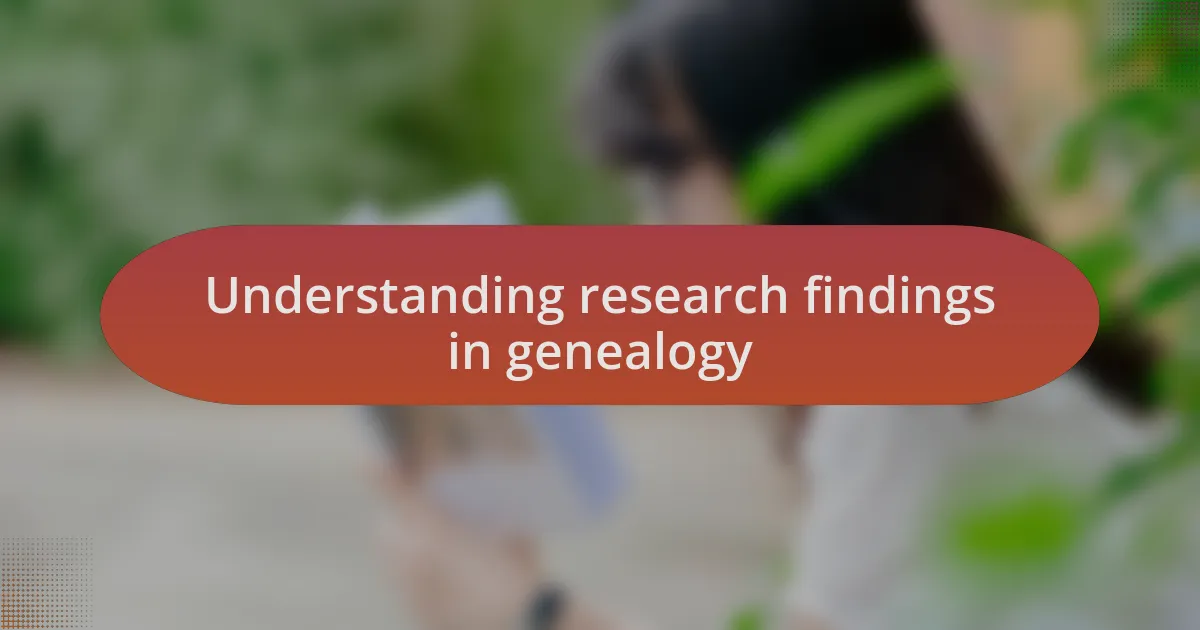
Understanding research findings in genealogy
Understanding research findings in genealogy can sometimes feel overwhelming. When I first began tracing my family roots, I was filled with a mix of excitement and confusion. It’s not just about collecting names and dates; it’s about piecing together a rich tapestry of stories that breathe life into those names.
As I sifted through various records, I often found conflicting information that left me questioning the reliability of my sources. Have you ever encountered a story that didn’t quite add up? Each discrepancy urged me to dig deeper, leading to valuable discoveries about my ancestry that I never anticipated. The journey of understanding these findings is not just about getting to the truth; it’s also about embracing the connections we uncover along the way.
I remember the moment I found a census record that revealed my great-grandfather’s occupation. It suddenly made sense why he had the skills he passed down to my father and eventually to me. This was an “aha” moment that solidified my understanding of how research findings connect us not only to our ancestors but to our own identities as well. Each discovery is a thread that weaves our family story together, inviting us to explore the past with open hearts and curious minds.
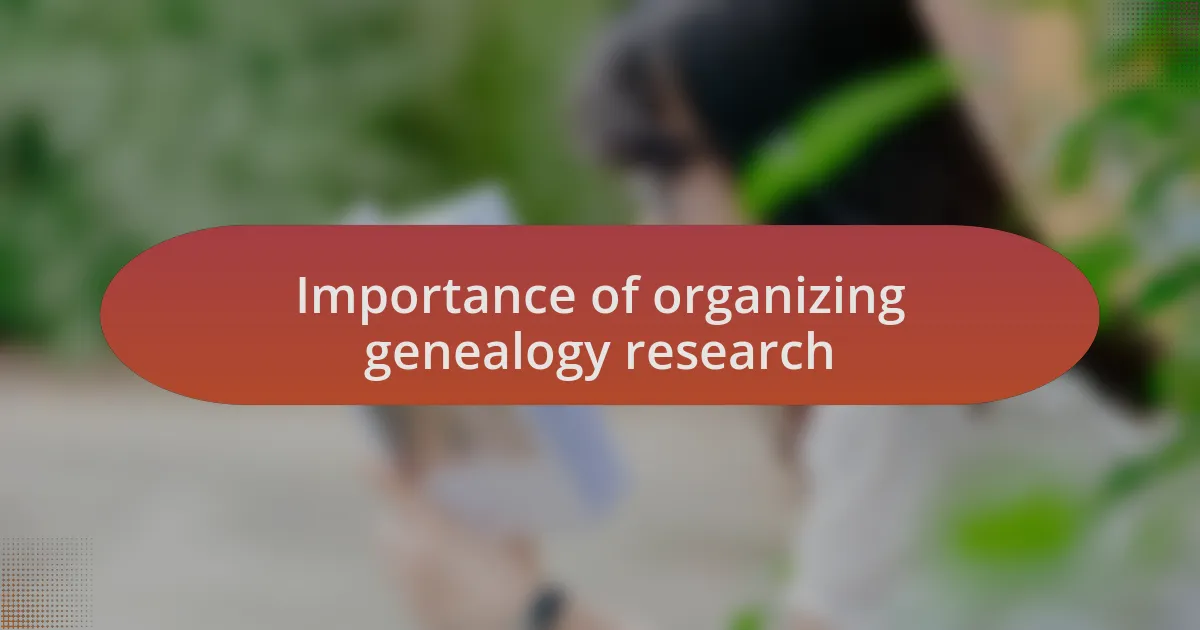
Importance of organizing genealogy research
Organizing genealogy research is crucial because it transforms chaos into clarity. I recall the early days of my own research when documents and notes sprawled across my dining table. It was hard to see the connections clearly amid the clutter. By creating an organized system, I found that I could easily identify gaps in my research and focus on what truly mattered. Isn’t it more satisfying to have a clear picture instead of a jigsaw puzzle with missing pieces?
Moreover, a well-organized archive helps ensure that the incredible stories of our ancestors don’t get lost in the shuffle. There was a time when I stumbled upon an old letter from a distant relative—an invaluable piece of my family history. However, because I hadn’t categorized my documents well, it took me weeks to locate it again. Can you imagine losing a vital link to your past simply because of disorganization? With everything neatly arranged, I could spend more time exploring those stories rather than searching for them.
Finally, the satisfaction that comes from an organized approach often motivates continued research. When I streamlined my findings into a user-friendly format, I felt so empowered that I was eager to share my discoveries with family members. I’ve realized that a clear organization not only clarifies my understanding but also creates an engaging narrative that I can vividly share with others. Isn’t that what genealogy is all about—connecting with others through the rich tapestry of our shared histories?
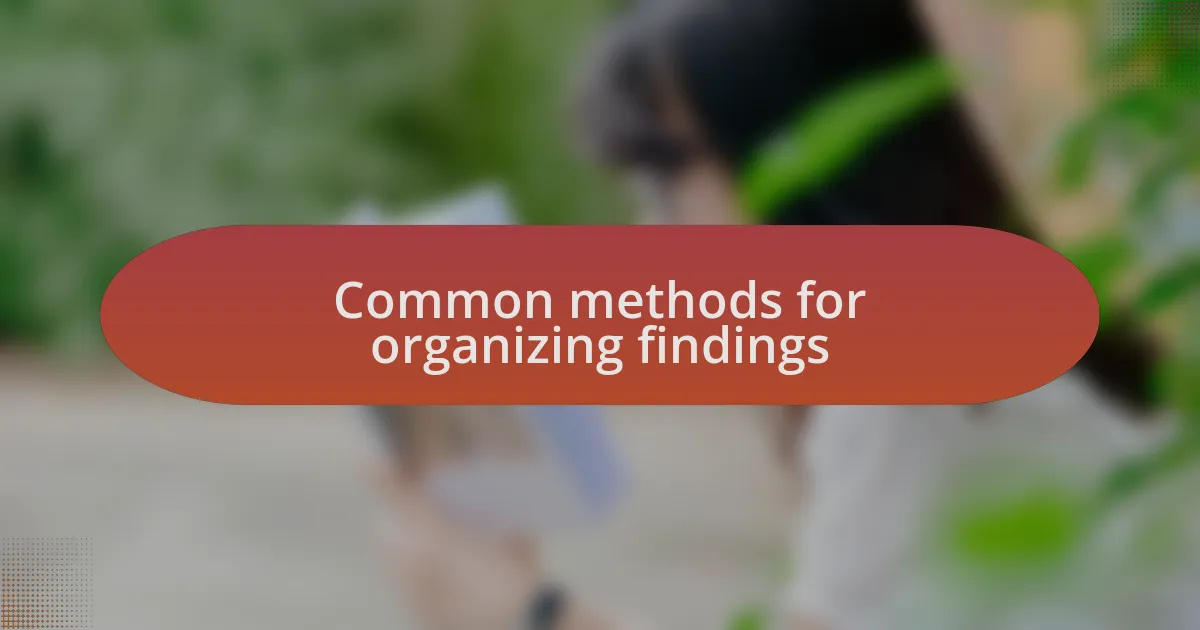
Common methods for organizing findings
One common method I often use to organize my genealogy findings is creating a family tree diagram. The visual representation of relationships helps me easily see connections and identify branches that need more research. I remember the thrill of drawing my great-grandparents’ lineage, seeing it expand as I added names and dates. Isn’t it fascinating how a simple diagram can breathe life into your family history?
Another effective approach is leveraging digital tools and software specifically designed for genealogy. I can’t stress enough how much my research transformed when I began using a program like Family Tree Maker. With the ability to attach documents, photos, and notes directly to individuals in my tree, everything felt more cohesive. Have you ever wished to access your findings from anywhere? Those tools often offer online access, making my research portable and always within reach.
Lastly, maintaining a research log has proven invaluable for tracking what I’ve done and what remains on my to-do list. I started documenting my searches, sources, and even the dead ends I’ve encountered. It might seem tedious, but I’ve found it helps me avoid repeating efforts. Doesn’t it feel great to have a clear roadmap of your progress? Plus, reflecting on my past searches often sparks new ideas for future inquiries.
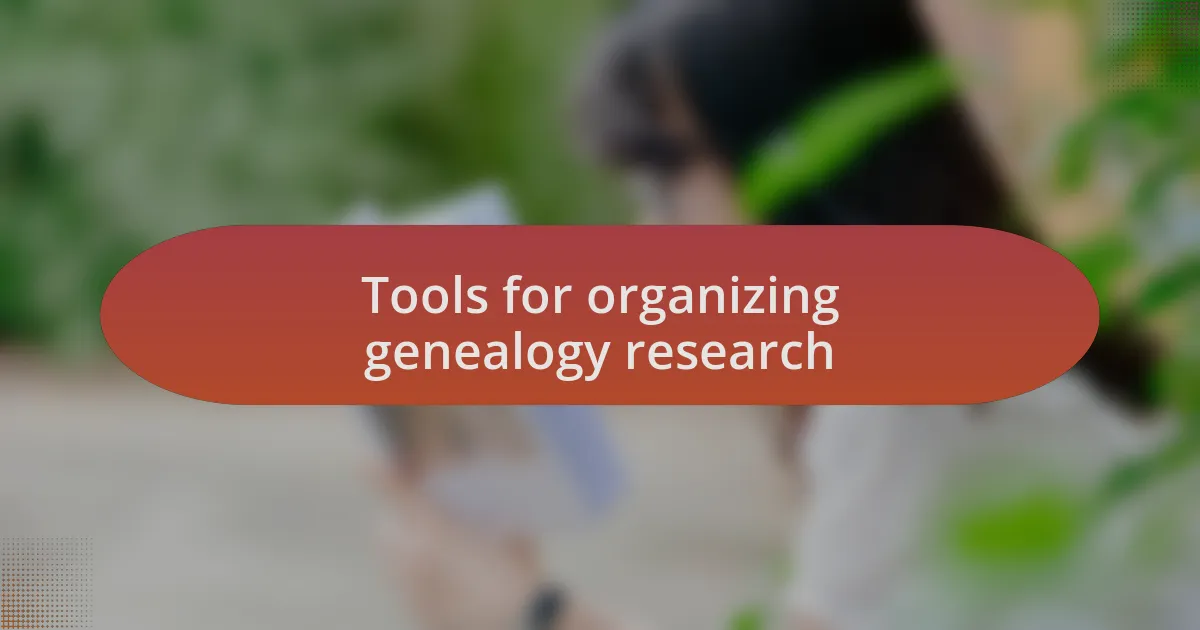
Tools for organizing genealogy research
When it comes to organizing genealogy research, technology is a game-changer. I vividly remember the first time I discovered Evernote. This note-taking app allowed me to compile notes, images, and documents all in one place. I was thrilled to see how easily I could tag and categorize my findings. Isn’t it satisfying to have everything organized at your fingertips?
Another tool that has greatly enriched my research process is the use of cloud storage systems, like Google Drive. I find it reassuring to have my documents saved securely online, so I can access them from any device. Just the other day, while sitting in a coffee shop, I pulled up my family documents on my phone to review some notes while waiting for a friend. Have you ever had that same surge of efficiency when you can access important information on the go?
Moreover, I can’t overlook the benefits of genealogy-focused social media platforms. Joining a Facebook group dedicated to family history research has opened new doors for me. I’ve connected with fellow enthusiasts who share tips and insights, and I even found a distant cousin that I’d never have discovered without their help! Isn’t it amazing how collaboration and community can enhance our research efforts?
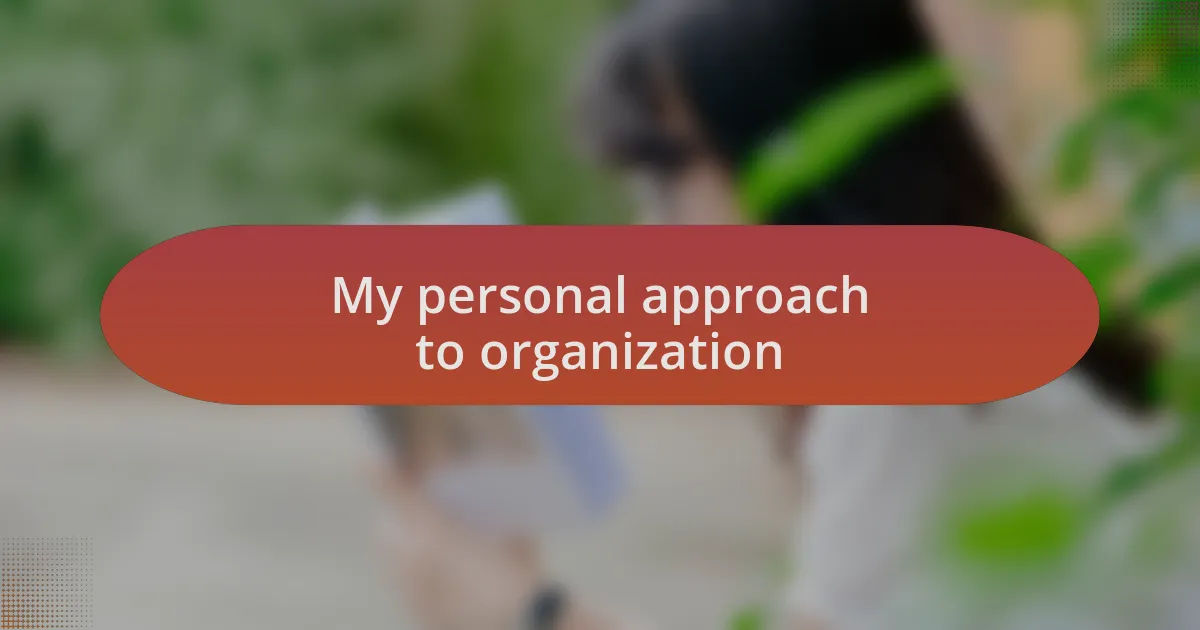
My personal approach to organization
When it comes to my personal approach to organization, I believe that a systematic yet flexible method is key. For instance, I maintain a research diary where I jot down thoughts, breakthroughs, and even frustrations. This practice not only keeps my research focused but also serves as a reflective space for me to review how far I’ve come. Have you ever felt the power of looking back to reaffirm your journey?
I also like to create color-coded folders for different branches of my family tree. Each color represents a branch, making it visually appealing and easy to navigate. I remember one time when I was deep diving into my paternal lineage; the color-coded system allowed me to find crucial documents quickly. Doesn’t it feel less overwhelming when everything is visually organized?
Lastly, I often set aside a specific time each week for organization. This allotted period has become a ritual where I can sort through my notes and multimedia files. I find it incredibly satisfying to make progress in these sessions, almost like a mini-celebration for each new discovery. Have you ever experienced that rush of accomplishment from simply organizing your findings?
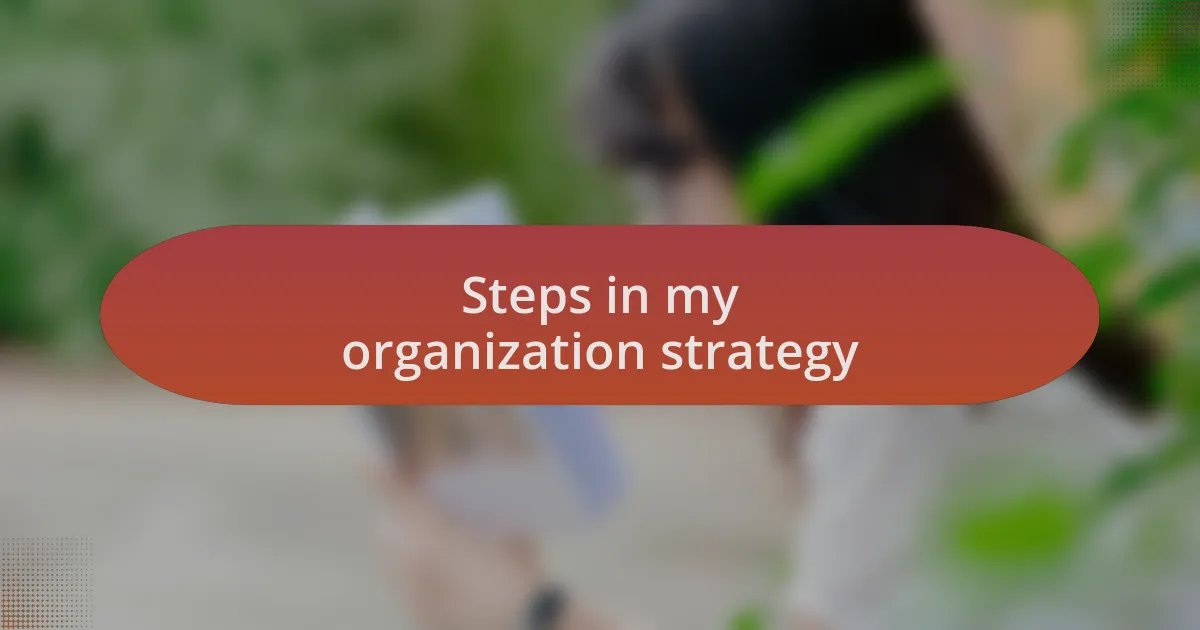
Steps in my organization strategy
One crucial step in my organization strategy involves establishing a clear categorization system right from the start. As I sift through documents and data, I assign each piece a specific label based on content and relevance. I recall a time when I was overwhelmed by stacks of papers related to my great-grandfather’s military service. By breaking it down into categories like “military records,” “personal letters,” and “photos,” I transformed chaos into a manageable system. Don’t you find that having designated categories makes it easier to navigate your findings?
Another important aspect of my strategy is maintaining a digital backup of all research. While I love working with tangible documents, I firmly believe that technology can be a researcher’s best friend. I remember accidentally spilling coffee on my notes once—I almost panicked! Since then, I’ve made it a priority to scan vital records and store them securely in the cloud. This dual approach not only protects my research but also allows me to access it from anywhere. Have you ever thought about how much your peace of mind could improve with a reliable backup plan?
Lastly, I always prioritize regular reviews of my findings. Once a month, I dedicate time to revisit and reflect on what I have gathered. During one of these sessions, I stumbled upon a forgotten lead that led me to a distant cousin I still keep in touch with today. This practice rejuvenates my motivation and often uncovers hidden gems in my research. Isn’t it exhilarating to rediscover something you thought was lost in the shuffle?

Tips for effective research management
When it comes to effective research management, I’ve found that setting incremental goals significantly enhances productivity. I often establish milestones for myself, whether it’s completing a certain number of interviews or analyzing specific documents related to my family tree. One particularly rewarding moment came when I set a goal to trace my maternal lineage back three generations. Achieving that felt like unlocking a door to my past.
Creating a centralized document where I record my sources is another tip that has saved me countless hours of searching. Early on, I struggled with tracking where I found particular pieces of information, often leading to frustration and wasted time. Now, I maintain a spreadsheet that includes the source title, date accessed, and a brief note about what I learned. This method not only streamlines my research but also builds credibility and reliability in my findings. Have you ever lost track of an important source right when you needed it the most?
Ultimately, continuous learning is at the heart of research management. I regularly attend webinars and read new articles that explore fresh methodologies or tools to aid in genealogy. I remember attending a workshop that introduced me to mapping software, which completely transformed the way I visualize family connections. This ongoing education keeps my approach dynamic and exciting, allowing me to stay engaged and inspired in my journey. What new skills have you explored recently that have added value to your research?